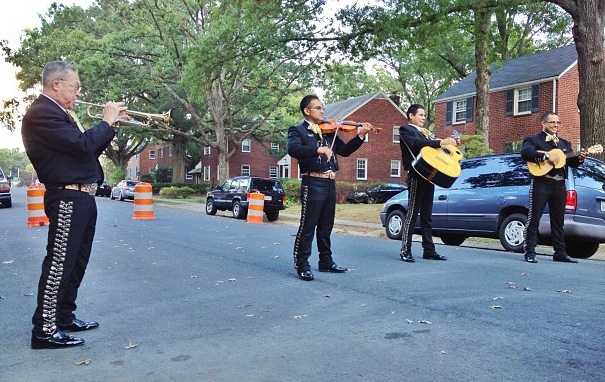Song For The Living

*This isn’t exactly a Juan Gabriel tribute, but it’s what film makers might call a reaction shot. You’ll find here a snapshot of the people who loved his music. VL
 By Diego Renteria, Tell Your True Tale
By Diego Renteria, Tell Your True Tale
As a teenager, I was part of a mariachi group with high school friends. We performed at birthday parties, masses, quinceañeras, and weddings around Southern California, each time becoming part of someone’s special occasion.
We always hesitated about taking gigs after December 15th because members traveled with their families for the holidays. In 2006, however, almost all our members stayed in our town of South Gate for Christmas, so that year we accepted a Christmas Eve gig because it was a one-hour performance in our hometown.
I arrived at the house about a half hour early and warmed up with my fellow musicians at a nearby strip mall parking lot. The night was chilly and our thin trajes were no match for the cold. I worried about not being able to feel or control my fingers in the cold but looked forward to a quick festive performance without worrying about being harassed by a drunk.
We walked down their driveway to their backyard. Most of the backyard was taken over by a stucco-on-chicken-wire two-story rear unit that looked perpetually under construction. A few people sat around a small fire in the center of the backyard, eating tamales from disposable plates and staying warm by the fire. The lights in the front unit were on and the smell of pozole wafted from the open kitchen door to the backyard.
They had hired us but did not seem very invested in our performance. I was accustomed to the occasional grito or exhortation in the middle of songs, clapping at the end of songs, and song requests, but this audience seemed unusually indifferent. As we encircled the family members and sang for them, the embers and smoke from their fire blew towards us, enveloping us and choking us.
When our hour was done, we bowed and started to take our leave. One of the men stopped us.
“Stay for one more hour.”
I did not expect anyone in the house to notice us leaving, let alone ask us to stay.
“Can’t. It’s Christmas Eve and we agreed to only one hour. We have to go be with our families.”
“I’ll pay five hundred dollars for the second hour.”
“Sorry, we really have to go.”
“Seven hundred dollars?”
“Look, we must…”
“One thousand.”
“We’ll talk about it with the rest of the group.”
We thought he was bluffing about the money. He gave us $500 and said he would give us the rest at the end. One hour of our time on Christmas Eve was worth $1,000 to him. Usually we charged $300 an hour.
We started singing, happy we were each getting over $100 for that night. He was pleased to have us at the family reunion for one more hour – more cheer for the house. Because it was Christmas, we tried our best to keep our songs cheerful or boisterous. We also played a few songs of heartbreak and loss because we knew they wanted to hear them. Their gritos indicated we were right.
About twenty minutes in, a woman emerged from the house and asked, “Can you come inside and play a song for us?”
We filed into the house through the kitchen and I noticed everyone outside the house followed us inside.
We walked into their living room. There, beside the Christmas tree and gifts and above the mantel was a large framed portrait of a boy no more than twelve years old. He looked down on everyone, eternally smiling for a school portrait, his hair spiky and clad in a gray school polo shirt. On a nearby stool were a backpack and some toys. On the mantel was an unwrapped tamal, a glass of milk, and two cookies. The couches were arranged to face his portrait.
I knew what song they would request and secretly hoped I was wrong.
“We want you… to play ‘Amor Eterno’ for our son…”
“Amor Eterno” was composed by the Mexican ranchera singer Juan Gabriel. Juan Gabriel is said to have composed the song to the memory of his mother and as the title (“Eternal Love”) suggests, it speaks of the pain of remembering the loss of a loved one who will never be forgotten or replaced. The suffering is so strong that the narrator prefers sleep because the pain disappears. “Amor Eterno” is almost solely requested at funerals or wakes or by people remembering their loved ones.
I don’t like performing “Amor Eterno.” It elicits such sadness and despair in listeners. There is always at least one person who starts crying. I feel bad for them and don’t know whether to cry or hang my head. Other mariachis have told me they feel the same. Our group vowed to play this song only when requested because it was too sad for most occasions.
We anxiously looked at each other. Our singer for “Amor Eterno” was sick at the time. Luckily, another member knew the lyrics and could sing in range. We were saved from the embarrassment of not being able to play the song.
We stood in a semicircle behind the couches. The family sat on the couches or in the doorways. Everybody in the room looked at the portrait.
They started crying as we started to sing. I stopped paying attention to who cried when. We mariachis exchanged glances to distract us from the mourning. Everything seemed to stop. No glasses clinked, no laughter punctuated the song. Everyone started singing to their son, their nephew. His mother broke down in tears on the couch, comforted by his madrina. A man who seemed to be his father stood against a wall, stone quiet.
The song ended but the family’s sobs did not. We filed out and finished our hour outside the house, colder than before we entered.
Read more NewsTaco stories n Facebook. >>
The man who paid us $1000 for the extra hour was in the street, burning rubber in his truck, drunk. Family had to drag him out of the truck. He kept his word and paid us the remaining $500.
We went home to our families that night. I went straight to sleep. But I think about that family, and the boy whose name I never knew, every Christmas Eve.
This story was originally published in Tell Your True Tale.
Diego Rentería is a semi-retired mariachi musician who plays the guitar, vihuela, and guitarrón and now lives in Boston. This story grew out TYTT workshops at East L.A. Public Library in the winter of 2014 and was first published in the book, Tell Your True Tale: East Los Angeles, Volume 1. Read more of his writing at http://soledadenmasa.wordpress.com.
[Photo by Alves Family/Flickr]
